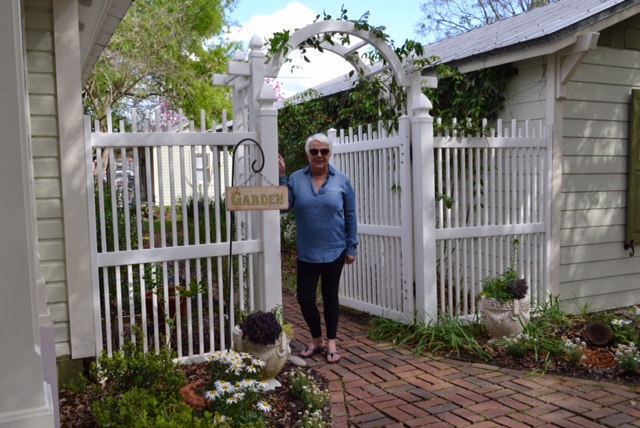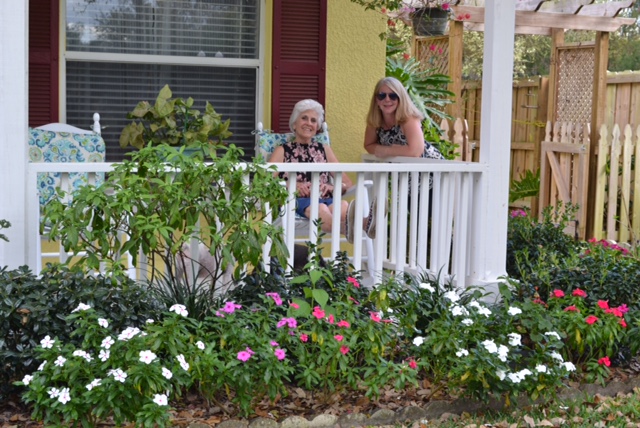Mary, Mary, quite contrary
How does your garden grow?
With silver bells and cockleshells
And pretty maids all in a row.
Kimberly Jones
What strange rhymes we learn as children! I’ve often wondered what made Mary so contrary. Since moving to Central Florida in 2010, I think perhaps Mary was trying to garden here in Seminole County. I wouldn’t call myself inexperienced; I love to dig in the dirt. My husband, Brian, and I have owned homes in seven of these United States and have always reworked their landscaping. Now we’ve moved into a rambling, old, green house in Sanford’s Residential Historic District. I’ve dubbed the place Casa Verde, and while it may not be anyone else’s vision of a dream house, it’s mine. I intend to live here for a long time and would love to create a vibe one of my favorite bloggers, Frances Schultz, describes as “something between a garden shed and a manor house.”
But how? There are many questions about sun, soil, irrigation, and what to grow anywhere you live, but our area is pretty persnickety. We learned this the hard way.
Our prior home in Sanford was a townhouse with a small courtyard. We thought it would be easy to have a small oasis between the dwelling and the garage. Wrong. The only successful plant out of many we tried was a little tree I brought from Alabama. It entered the state with only one leaf hanging on for dear life. Not one to give up easily on any living thing, I placed it in a sunny spot inside where it outgrew its pot, then a larger pot, and then another, still larger pot. We decided to buy a really large pot and set it outside in the courtyard. It was fascinating to watch it do so well. Before too long, it was as tall as the second story, and reminiscent of the man-eating plant in Little Shop of Horrors. It burst its terra cotta pot, and sent roots deep into the ground, where we feared it would invade the foundation of the townhouse. Armed with an axe and a box of contractor-sized trash bags, Brian chopped the ficus down, leaving the refuse collectors shaking their heads at how so much debris could come from so small a space. I learned the little tree from a market in Alabama was nicknamed ‘strangler fig’. I also learned how quickly invasive species can take over. If not careful, your garden can turn into a jungle almost overnight.
The inability to cultivate such a small space at the townhouse left me a bit bewildered. Upon moving to Casa Verde in January 2017, I thought my problem was solved. The foundation plantings were lovely and freshly planted. Despite being a southern girl, I was not a huge fan of the azaleas and planned to dig them up myself if I couldn’t cajole Brian into it. All I planned to do was plant annuals which totally satisfies my need to dig in the dirt and provide the instant gratification of vivid color. Expensive, but I suppose there are worse habits.
The hot summer of 2017 was not at all kind to the landscape at Casa Verde, and September’s Hurricane Irma was downright rude. A few overnight freezes in early 2018 have pretty much zapped everything. I fear I’ve become an overzealous pruner. On the bright side, the few scraggly azaleas are probably down for the count. And this has given me a great reason/excuse to pose the question asked of Mary to a few of my neighbors here in the District whose gardens I admire: “How does your garden grow?”
If you’re taking a stroll in Sanford’s Historic District and see a perfect little red truck driven by a precious lady in starched overalls and round glasses, that’s likely to be Brenda Boland. Originally from Lake Eerie, New York, Brenda moved to Sanford in 2011. She’s pondered a bit herself about all things gardening and landscaping around her distinctive white, black, and red cottage on one of our avenues. (Brenda has a knack for finding just the right pop of red.) Small palm trees are abundant in her yard and around the house. I asked about the palms and she replied, “You know when you live in New York, you always think of Florida and palm trees.” I was intrigued by her many small, manageable palms, especially the Robellini (pygmy date) Palm. Many other tropical plants seemed barely nipped by the recent cold weather, but Brenda never covers anything up when the forecast calls for freezing temperatures. She does have a few plants in pots so she can move them into more protected areas, which works when the hot summer sun threatens as well. Having tropical plants in containers also helps contain their growth. Brenda is a brilliant lady; advice taken, even though I’ll never take my eye off of another contained plant.
Brenda describes herself as a ‘DIY gardener’ and notes we are fortunate to live in a community of helpful, longtime residents who love to share their gardening expertise. They also love to share bromeliads, cardboard palms, and other ‘volunteer plants’ threatening to overcrowd the landscape. The pair of large oak trees in front of the Boland’s house were planted years ago by a neighbor who still lives two doors away. He offers excellent advice on how to deal with the plants we love. Brenda learned from him it’s best to leave the frost-bitten brown leaves on plants until the threat of freeze warnings is over, so the freshly pruned areas aren’t exposed to the elements. More good advice, though it’s hard to look at droopy hibiscus leaves.
Another Sanford gardener I am proud to know and call my new friend is Noma Prescott. Not only is Noma excellent at growing pretty flowers and shrubs, she also holds a green thumb in vegetable gardening. I admire someone who grows actual food. You won’t find eighty-something year young Noma sitting idly by watching all this Florida sunshine go to waste. Her collards are doing well right now, and because of the frost they will be sweeter. She is intrigued by the brussels sprouts she just started and explained the sprouts will develop on the stalks. I explained how I know that only because I’ve seen them for sale at the grocery store that way. I mentioned how Brian and I once grew our own tomatoes when we lived in Ohio. The master admitted she has a hard time growing them here in Sanford. We spent a while talking about ways to use tomatoes in many delightful ways because we are, after all, both southern girls who love to cook.
A native of Northwest Florida, Noma spent time in Tennessee before moving to Sanford about two years ago. She’s found gardening to be a bit different here. She cuts to the real nitty gritty of the issue – the soil. She is a believer in keeping many plants in pots because it’s easier to get a better soil mixture. It also makes adding slow release fertilizer easier. As far as flowers and shrubs, she has her likes and dislikes. She isn’t a fan of the Burford Holly as foundation plants, but they are healthy. (I should offer to trade her some almost-dead azaleas). Noma’s pink and gold shrimp plants look fantastic, so I asked her pruning advice: “Years ago, Kim, I heard the best time to prune is when your knife is sharp.” Noma also advises keeping that knife sharp to cut away the parts of your plants where pests reside. It’s also important to squish them before you discard them since they might get back on something else you’re trying to grow. I think I have another job for Brian.
Linda Kuhn is a longtime resident, former mayor of Sanford, and one of the proprietors of Diamond Glass located right here in the Historic District. She is also a wealth of knowledge for all things Sanford. We often admire her lawn and garden when we walk our dog. It’s along one of our many routes.
I was excited to speak with Linda and talk about the conditions we face in our area and how it impacts our gardens. She is a wealth of knowledge and has a great deal to share about Florida-friendly plants. Unlike many of us, Linda has a lot of shade in her yard, so she has luck with Impatiens pretty much all year. They give her the most bang for her gardening buck. It makes me a little jealous because the SunPatiens I planted last year were sun-withered by early summer. Linda advises to find the shadiest areas, even for SunPatiens. A recommendation for sunny areas is garlic vine which will bloom from summer into fall. African iris is another favorite and does well in the sun.
Linda also loves Bougainvillea! She has a different take on the bush/shrub/tree. The plant is not just another pretty face with its showy blooms. A hedge of prickly Bougainvillea adds a level of security to your property. Linda’s background in law enforcement makes her practical in many ways.
The planting beds around Casa Verde are nearly down to a clean slate, but it’s exciting to put my own spin on things and try some tropical plants, a few things in containers, and some vines. And you can bet there will be a be a Bougainvillea or two.
Now, armed with lots of advice, I owe my gardening friends much appreciation. It’s gratifying to live in a community where neighbors, though shy about their accomplishments, love to share. Brenda, Noma, and Linda, I thank you for your wellsprings of knowledge. You all are most kind and have been so very helpful. I hope we’ve all helped a few gardeners become a little less contrary. And if anyone has had any gardening luck with silver bells, cockleshells, or pretty maids all in a row, please let me know.


 My Sanford Seminole Magazine LIFESTYLE | BUSINESS | TOURISM
My Sanford Seminole Magazine LIFESTYLE | BUSINESS | TOURISM
